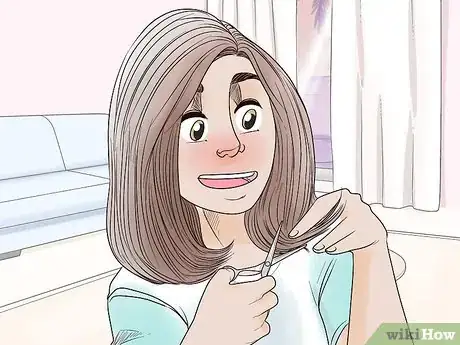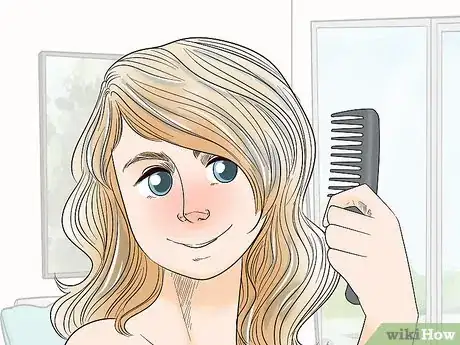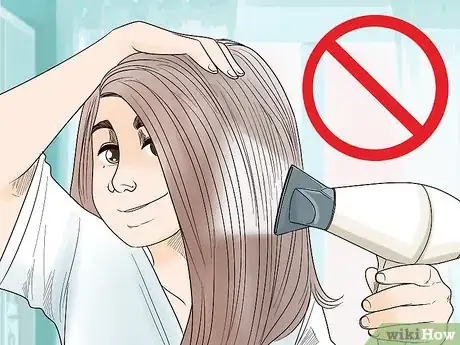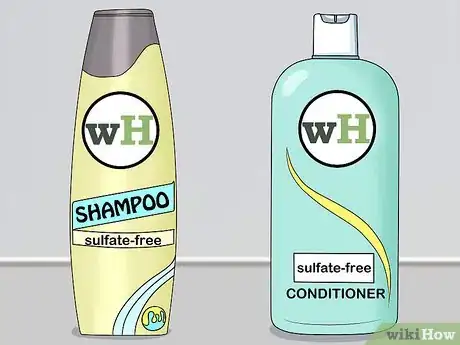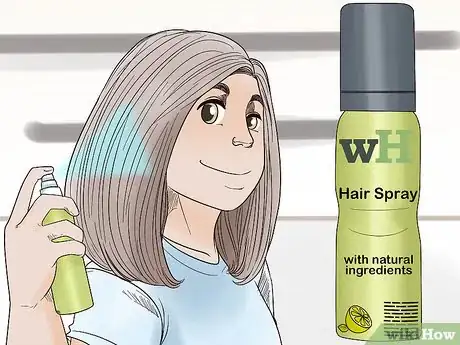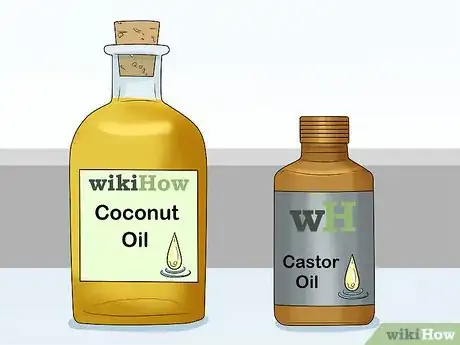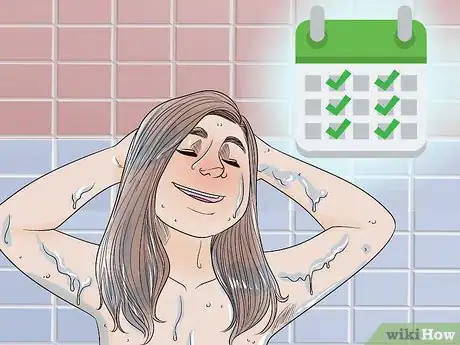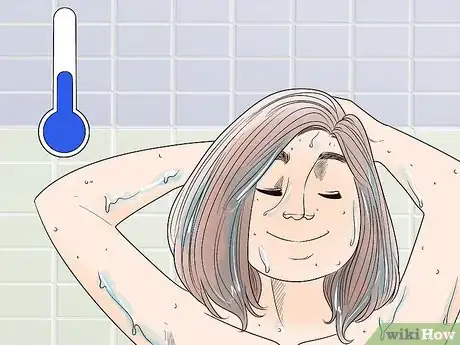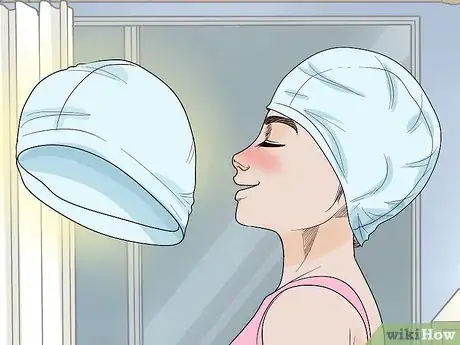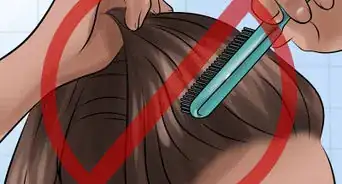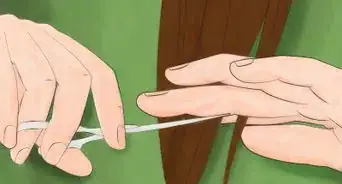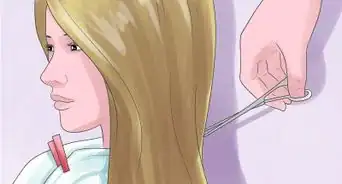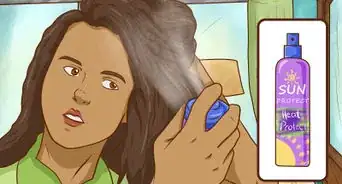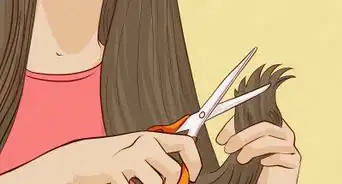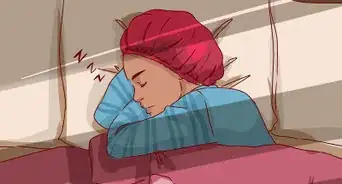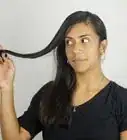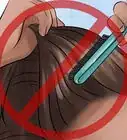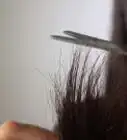This article was co-authored by Jenny Tran and by wikiHow staff writer, Sophia Latorre. Jenny Tran is a Hair Stylist and the Founder of JT Hair Lab by Jenny Tran based in the Dallas, Texas metro area. With over seven years of professional hair styling experience, Jenny specializes in hair coloring, haircutting, and hair extensions. JT Hair Lab is an authorized carrier of R+Co and of Milbon and is committed to using products with quality ingredients.
There are 9 references cited in this article, which can be found at the bottom of the page.
This article has been viewed 754,384 times.
Is your hair dry and dull? Do you have split ends and frizz? Hair is damaged easily, and it takes time to repair it. The good news is, there are several easy techniques you can use to restore the health of your hair and keep it looking great.
Steps
Rescuing Damaged Hair
-
1Trim split ends.[1] The best way to deal with split ends is to trim them off. Despite product claims about fixing split ends, they can only be removed, not repaired. Cutting your hair will immediately make it look fresher and restore its body. Aim to get a trim every 6 to 12 weeks, depending on the length, texture, and style of your hair.[2]
- Ensure your stylist is using extra sharp scissors. Ask them to cut into a wet tissue and inspect the cut—if you see torn tissue fibers, find another stylist.
- Cut off as much as you dare. Hair is more damaged at the ends due to increased exposure to heat, chlorine, and so on.
- Ask the stylist not to blow dry your hair or use any heat-styling tools as these will further damage unhealthy hair.
-
2Be gentle with wet hair. Hair is most susceptible to damage when it’s wet.[3] Avoid vigorously scrubbing your hair in the shower or rubbing it with a towel to soak up excess moisture. Use a wide-tooth comb to detangle your hair starting at the ends and working up towards the roots. You can do this when it’s wet, but make sure to apply a detangling product first.[4]Advertisement
-
3Stop using heat-styling tools. Heat can make your hair look dull and damaged, so it’s best to avoid using heat-styling tools as much as possible.[5] Let your hair air dry and style it with heat-free techniques, like rollers or hair wrapping.[6]
- Only use blow dryers, curling irons, and flat irons after applying a heat-protectant product to your tresses. Keep the tools on a low setting to further protect your hair, rather than cranking up the heat as high as it will go.
- Ionic, ceramic heat-styling tools infused with keratin and argan oils are your best bet for limiting heat damage.
-
4Avoid dyeing and processing your hair. Bleaching the color from your hair, then adding chemicals to dye it another color is extremely damaging. Bleaching or dyeing hair can lead to hair breakage, hair loss, and bald patches. Permanent curling or straightening processes are also damaging and should be avoided.
Using Restorative Products
-
1Opt for sulfate-free shampoo and conditioner. Hair care products made with sulfates can irritate the skin on your scalp, dry out your tresses, cause frizzy hair, and fade color-treated hair. Avoid shampoos and conditioner made with sodium lauryl or laureth sulfates. These industrial cleaning agents strip hair of its natural protective oils.
- When you begin using sulfate-free shampoo and conditioner, your hair may look slightly oily because your body has grown used to overproducing the oils necessary to maintain healthy hair. Ride it out. It should only take a few weeks for your scalp to regulate its production of oil.
-
2Use natural styling products. Most hair sprays, gels, mousses and other commercial styling products contain chemicals that can damage your hair. Avoid these and instead pick products with the fewest amount of ingredients possible. Opt for products that contain natural ingredients, like rosemary, seaweed, honey, olive oil, and avocado oil.[7]
- You can make your own hairspray using citrus fruits as a great natural alternative to chemical-based sprays.
- You can also make your own hair gel using a simple mixture of water and gelatin, or even a vegan alternative using only water and flax seeds or fresh aloe vera gel.
-
3Treat your hair with oil. No matter what your hair type, oil can help restore moisture and keep your locks shiny and smooth. You can use coconut, olive, castor, argan, almond, or egg oil. Simply massage the oil into your hair, let it sit for 15 minutes, then rinse it out with lukewarm water.[8]
- Place a shower cap over your oiled tresses to minimize the mess.
- You can even sit under a hooded dryer or direct the heat from a blow dryer at your hair to increase the effectiveness of an oil treatment.
Practicing Long-Term Maintenance
-
1Wash your hair only 2-3 times per week. Washing your hair every day dries it out, since it doesn't give your scalp the chance to produce the oils your hair needs to stay healthy. Shampooing less frequently can help repair damaged hair.[9]
- Simply rinse your hair in the shower rather than washing it daily.
- Apply dry shampoo to your roots to absorb excess oil between washes.
-
2Rinse your hair with lukewarm or cool water. Hot water damages hair, but cool or cold water closes the cuticle and helps the hair shafts to lie flat. Rinsing out your shampoo and conditioner with cold water will give your hair a shiny, glossy appearance.[10]
-
3Wear a swim cap in the pool. Chlorine causes damage that builds up over time. Always wear a cap when you go swimming to protect your tresses, especially if your hair is color treated.[11]
- If you go swimming without a cap, make sure to wash your hair with a clarifying shampoo afterwards.
- Don't sit in the sun after swimming without a cap, because the sun's rays will compound the damage done by chlorine. Wash it out before you sunbathe.
-
4Eat healthy foods to strengthen your hair. Like other parts of your body, your hair is affected by what you eat and drink. Get plenty of water, vitamins, and essential nutrients. Aim to eat a healthy diet containing protein, iron, and biotin.[12]
- Omega-3 fatty acids are good for hair and skin. Eat salmon, walnuts, flax seeds, and other sources of this beneficial fatty acid.
- Eating spinach, kale, carrots, and avocados can also improve the health of your hair.
Expert Q&A
Did you know you can get expert answers for this article?
Unlock expert answers by supporting wikiHow
-
QuestionHow do you fix fully damaged hair?
 Laura MartinLaura Martin is a Licensed Cosmetologist in Georgia. She has been a hair stylist since 2007 and a cosmetology teacher since 2013.
Laura MartinLaura Martin is a Licensed Cosmetologist in Georgia. She has been a hair stylist since 2007 and a cosmetology teacher since 2013.
Licensed Cosmetologist
-
QuestionCan coconut oil help repair damaged hair?
 Laura MartinLaura Martin is a Licensed Cosmetologist in Georgia. She has been a hair stylist since 2007 and a cosmetology teacher since 2013.
Laura MartinLaura Martin is a Licensed Cosmetologist in Georgia. She has been a hair stylist since 2007 and a cosmetology teacher since 2013.
Licensed Cosmetologist
-
QuestionCan coconut oil help repair damaged hair?
 Laura MartinLaura Martin is a Licensed Cosmetologist in Georgia. She has been a hair stylist since 2007 and a cosmetology teacher since 2013.
Laura MartinLaura Martin is a Licensed Cosmetologist in Georgia. She has been a hair stylist since 2007 and a cosmetology teacher since 2013.
Licensed Cosmetologist
References
- ↑ Jenny Tran. Professional Hair Stylist. Expert Interview. 31 August 2020.
- ↑ https://www.allure.com/gallery/when-to-get-a-haircut
- ↑ Jenny Tran. Professional Hair Stylist. Expert Interview. 31 August 2020.
- ↑ https://globalnews.ca/news/4008990/how-to-fix-damaged-hair/
- ↑ Jenny Tran. Professional Hair Stylist. Expert Interview. 31 August 2020.
- ↑ http://stylecaster.com/beauty/heat-styling-tools/
- ↑ https://www.allure.com/story/best-natural-ingredients-for-your-hair
- ↑ https://www.cosmopolitan.com/uk/beauty-hair/hair/a35722/best-oil-for-your-hair-type/
- ↑ Jenny Tran. Professional Hair Stylist. Expert Interview. 31 August 2020.
About This Article
To repair damaged hair, start by getting your hair trimmed at your local salon to remove the split ends, since these cannot be repaired. Afterwards, use a sulfate free shampoo and conditioner 2 to 3 times a week, and rinse with lukewarm or cool water to help your hair retain its natural oils. Then, let your hair air dry and style it with a heat-free technique like hair rollers. Additionally, use styling products with the fewest ingredients possible since many of these ingredients are chemicals that can damage your hair. For more advice from our Beauty reviewer, including how to repair damaged hair with homemade oil treatments, keep reading.
